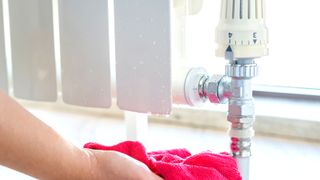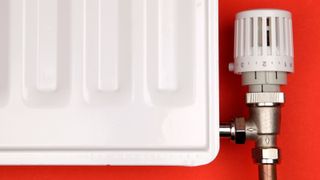How to fix a leaky radiator and stop unwanted water damage
Knowing how to fix a leaky radiator means you can sort any issues quickly and save on the cost of calling out a plumber

You’ll want to know how to fix a leaky radiator if your central heating suddenly springs a leak.
If you don't stop the leak as soon as possible you could cause serious water damage to the floor, damaging flooring or carpets. If the leaky radiator is upstairs, the water may also leak through a ceiling or even worse – into an electrical outlet. Plus, if you can’t fix it quickly you might have to go without water for a while and pay an expensive call out charge.
Small leaks are easiest to fix, it might be that you have been trying to work out how to bleed a radiator and when finished you didn’t tighten the valve enough. It could even be as simple as tightening a nut. But if not you need to get on the case quickly to stop the problem becoming worse.
Here we give you the lowdown on how to identify a leak, how to fix it and how much a professional will cost.
How to fix a leaky radiator: Identifying the problem
Before you locate the problem you need to stop as much water as possible leaking onto the floor. Mop up the water, lay down a few towels and put a container under the leak.
If the leak is coming from the radiator this should be easy to spot. Wipe dry the radiator and look for water dripping onto the floor. Now look up in a vertical line from the drip to locate the leak.
If it is the valve or pipes first dry the valves and pipes with a towel. Now place toilet roll in different positions and areas around the valves and pipes to locate the leak. First try the valve to radiator join and then the valve to water pipe join. Finally try the top of the valve.
How to deal with a leaky radiator body
If the leak is coming from the body of the radiator this is due to corrosion. This indicates that the radiator has rusted from the inside and it's pumping rust around your heating system. This isn’t good for your heating system and means it’s time to invest in a new radiator as soon as possible.
You can invest in a like for like radiator or use this opportunity to buy one of the best designer radiators that you have had your eye on for a while.
How to fix a leaking radiator valve
A simple quick fix is to tighten all the nuts on a radiator valve. This may not solve the issue, but if it does, it will be a quick and simple solution that will take no time at all.
Get a suitable spanner and gently tighten the union nuts. These are nuts that connect to the pipe that brings in the water and attach to the radiator. If this stops the leak, it’s job done. If not, it's time for the next step.
1. Stop water flow
Make sure the lockshield valve is closed. This sits on the top of the valve, typically under a plastic cap. Typically it will be fully open. Get a small spanner or pair of pliers and turn clockwise to fully close the valve.
2. Drain the radiator
Now undo the union nut – the nut that connects to the radiator. Make sure to have towels and a container to collect the water. Use a large container, if you don't have one, use two smaller containers to catch the water.
3. Add PTFE tape
Wrap the valve that goes into the radiator with PFTE tape, typically ten turns should be enough. Now do up the union nut to connect the valve back to the radiator. If the leak is coming from the part of the valve that connects to the water pipe, undo this and put PFTE tape on this thread and do up the nut.
4. Refill the radiator
Now open the lockshield valve to let water back into the radiator. To refill the radiator you will need open the bleed valve – located on the left or right at the top with a radiator valve key. As soon as water starts to come out of the bleed valve, close it. Now check if your repairs have stopped the leak. If not it may be time to replace the valve.
How do I fix a leaking thermostatic valve?
A thermostatic radiator valve (TRV) is similar to a manual radiator valve but has a few more parts where a leak may occur. If the valve is leaking from the radiator or water pipe then turn off (down to zero) and follow the steps as mentioned previously.
If this isn’t the cause and the TRV is leaking from within the valve the easy option is to buy a new valve and replace it. You can get these for as little as £10. Alternatively, you can buy spare parts and replace, but this is best done by a professional.

How much does it cost to fix a leaking radiator?
If it's only a leaking radiator valve then it won’t cost much more than an hourly rate. There may be a minimum charge - typically around £50 for a simple job. If the valve needs to be replaced expect to add another £30. If you have more than one valve to replace expect to pay at least £50 per new radiator valve.
If you need to call out a plumber in an emergency (typically out of hours) you can expect to pay at least £150. If they are there longer than an hour you will have to pay an hourly rate that will be at least double their standard hourly rate.
If the radiator is the problem it will cost more to fix. To remove and replace your old radiator expect to pay in the region of £150. If you are replacing a larger or double panel radiator expect to pay at least £200.
If you are replacing a corroded radiator you will probably need to have your heating system flushed to get rid of rust flakes. Prices will start at around £300 and rise depending on how many radiators you have.
If replacing a radiator (see our guide on how to replace a radiator) and are looking to move it to a different location it could be a good time to think about the cost to move a radiator or how to add a radiator.
Meanwhile, check out our other guides if you have other problems like a radiator not heating up, how to balance a radiator or want to know why else your radiator is not working.
Get the Homebuilding & Renovating Newsletter
Bring your dream home to life with expert advice, how to guides and design inspiration. Sign up for our newsletter and get two free tickets to a Homebuilding & Renovating Show near you.
Steve Jenkins is a freelance content creator with over two decades of experience working in digital and print and was previously the DIY content editor for Homebuilding & Renovating.
He is a keen DIYer with over 20 years of experience in transforming and renovating the many homes he has lived in. He specialises in painting and decorating, but has a wide range of skills gleaned from working in the building trade for around 10 years and spending time at night school learning how to plaster and plumb.
He has fitted kitchens, tiled bathrooms and kitchens, laid many floors, built partition walls, plastered walls, plumbed in bathrooms, worked on loft conversions and much more. And when he's not sure how to tackle a DIY project he has a wide network of friends – including plumbers, gas engineers, tilers, carpenters, painters and decorators, electricians and builders – in the trade to call upon.
